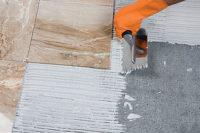But even though it has a solid market for roofing slate, Camara Slate has diversified its product line to meet the growing needs of North American consumers. Most notably, it has become involved with slate countertops. Clearly, natural stone countertops have been a boon for the industry, and the technical properties of Vermont slate make it a very suitable material for this application. In a prime example of this, our cover story showcases a private residence in rural Vermont, which makes use of Vermont slate for a broad range of applications, including countertops and flooring (page 62).
Homeowners have found that natural slate can be used to create an atmosphere of warmth in a residential setting. They are finding a wealth of colors, including traditional grays and blues as well as earth tones such as rust, beige and green. This issue also features residential projects in Illinois (page 80) and in California (page 84), and both of these homes relied upon slate flooring to bring a casual elegance to the design.
An in addition to countertops and flooring, slate producers are now using the material for finished products that had traditionally employed marble or granite. Our Focus on Slate also features a stone producer outside of Beijing, China, that uses slate and quartzite for hand-crafted mosaics. The company, P & L Inc., has previously been a producer of tile products and custom architectural work, but it expanded into mosaic production two years ago. Interestingly, the U.S. comprises 60% of the company's market, with products being sold in large-scale building supply stores.
Of course, slate still has a very important role in commercial building, particularly institutional projects where the material imparts a feeling of nobility and permanence. This issue's Focus on Slate is rounded out with two architectural features on a a new library in Southern California (page 56) and a cultural/performance center at Indiana University (page 74). In both cases, slate served to reflect the local surroundings -- the natural park setting in California, and the built campus environment in Indiana.
No matter what the application, the use of slate appears to be maintaining its popularity in the North American marketplace. And as the uses and varieties of slate continue to advance, the material will make further inroads in the field.
